状语从句9种
初中英语状语从句整理必背-多个例句强化规律

初中英语状语从句整理必背-多个例句强化规律以下是常考的9种状语从句及其常用的连词,每个连词后面列出了三个例句及其翻译,熟练背诵有助于理解长难句和写作提高拿高分或满分,同时综合填空等填空题型时态把握也有很大帮助,语言习得,只有通过多个例子强化练习,感悟才能达到孰能生巧的程度,加油,相信你能够成就最好自己。
时间状语从句常用连词:when, while, as, before, after, since, until(1)when: 当...时候,无论何时例句:When I was young, I liked to play with my friends. (当我年轻的时候,我喜欢和朋友们一起玩。
)When we have finished our work, we can go home. (当我们完成工作后,我们可以回家。
)When she sings, she sounds beautiful. (当她唱歌时,她的声音听起来很美。
)(2)while: 与...同时,当...时候例句:While I was cooking, my sister was watching TV. (当我烹饪的时候,我的妹妹在看电视。
)While we were waiting for the bus, we saw a dog on the street. (当我们等公交车的时候,我们在街上看到了一只狗。
)While she was writing her exam, she suddenly remembered something important. (当她在写考试的时候,她突然想起了重要的事情。
) (3)as: 当...时候,一边...一边...例句:As I was walking to school, I saw a cat chasing a bird. (当我步行去学校的时候,我看到了一只猫在追一只鸟。
状语从句(9种

1.时间状语从句常用引导词:when, as, while, as soon as, before, after, since , till, until特殊引导词:the minute, the moment, the second, every time, the day,the instant, immediately , directly, no sooner … than, hardly …when, scarcely … whenI didn’t realize how special my mother was until I became an adult.While John was watching TV, his wife was cooking.The children ran away from the orchard(果园), the moment they saw the guard.No sooner had I arrived home ,then it began to rain.Every time I listen to your advice, I get into trouble.2.地点状语从句常用引导词:where特殊引导词:wherever, anywhere, everywhereGenerally, air will be heavily polluted where there are factories.Wherever you go, you should work hard.地点状语从句§4地点状语从句 (adverbial clause of place) 地点状语从句一般由连接副词where, wherever等引导,已经形成了固定的句型,例如:句型1:Where+地点从句,(there)+主句。
【注意】此句型通常译成“哪里……哪里就……”;主句在从句后面时,there可用可不用;如果主句在从句的前面时,一般都不用there。
英语中的九种状语从句
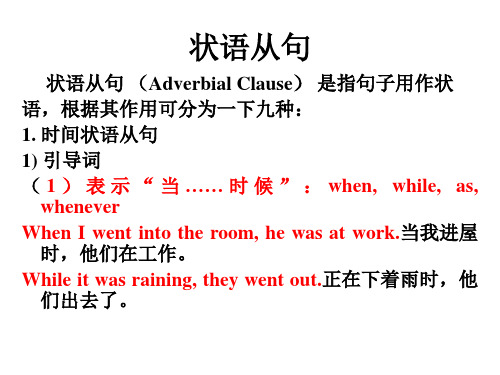
5、条件状语从句的引导词有if, if only(如果…… 就好了,但愿), unless, in case, as/so long as, provided that, providing that, suppose that, supposing that, on condition that , when。
(1)___the days went on, the weather got worse.
A. With
B. Since
C. While D. As
(2) ____the satellite launch drawing near,the research workers put their hearts to the test and always stayed up late.
状语从句
状语从句 (Adverbial Clause) 是指句子用作状 语,根据其作用可分为一下九种:
1. 时间状语从句 1) 引导词 ( 1 ) 表 示 “ 当 …… 时 候 ” : when, while, as,
whenever When I went into the room, he was at work.当我进屋
Even if I have to walk all the way I’ll get there. 即使我 得一路走着去,我也要走到那里。
• as引导的让步状语从句的结构是:名词(形 容词、副词、动词)+ as +主谓。如:
Child as he was, he knew what was the right thing to do. 尽管是个孩子,他知道要做的正确的事情 是什么。
英语状语从句的九种类型举例
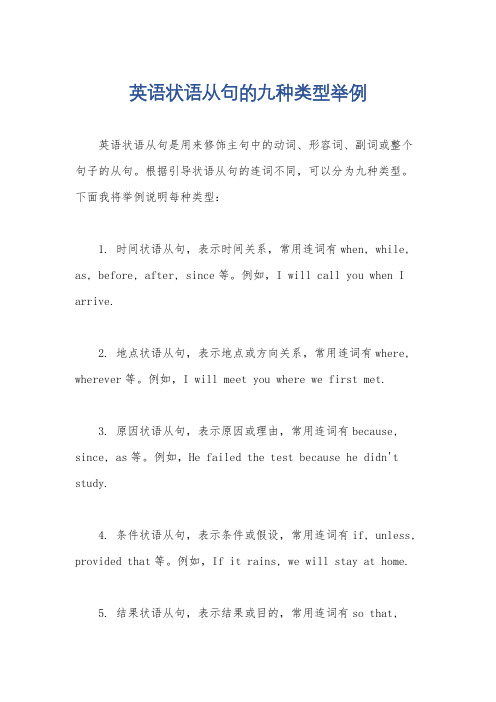
英语状语从句的九种类型举例英语状语从句是用来修饰主句中的动词、形容词、副词或整个句子的从句。
根据引导状语从句的连词不同,可以分为九种类型。
下面我将举例说明每种类型:1. 时间状语从句,表示时间关系,常用连词有when, while, as, before, after, since等。
例如,I will call you when I arrive.2. 地点状语从句,表示地点或方向关系,常用连词有where, wherever等。
例如,I will meet you where we first met.3. 原因状语从句,表示原因或理由,常用连词有because, since, as等。
例如,He failed the test because he didn't study.4. 条件状语从句,表示条件或假设,常用连词有if, unless, provided that等。
例如,If it rains, we will stay at home.5. 结果状语从句,表示结果或目的,常用连词有so that,such that等。
例如,She worked hard so that she could pass the exam.6. 方式状语从句,表示方式或方法,常用连词有as, as if, as though等。
例如,She sang as if she were a professional singer.7. 比较状语从句,表示比较关系,常用连词有than, as, as...as等。
例如,He is taller than I am.8. 让步状语从句,表示让步关系,常用连词有though, although, even if等。
例如,Although it was raining, we went out.9. 目的状语从句,表示目的或意图,常用连词有in order that, so that等。
状语从句的特殊用法大全
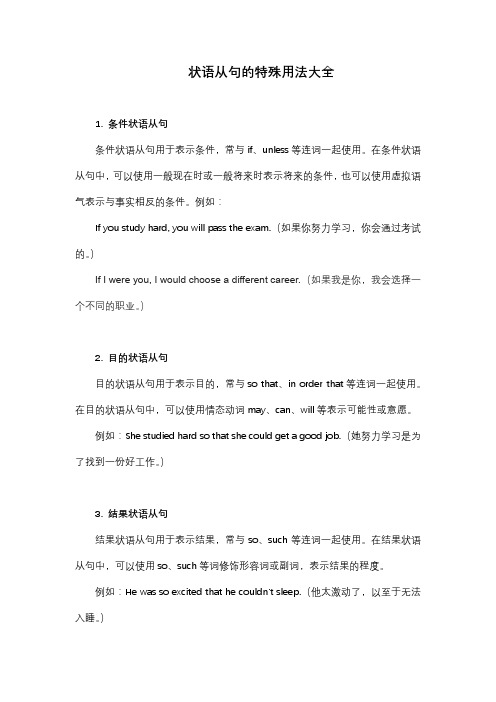
状语从句的特殊用法大全1. 条件状语从句条件状语从句用于表示条件,常与if、unless等连词一起使用。
在条件状语从句中,可以使用一般现在时或一般将来时表示将来的条件,也可以使用虚拟语气表示与事实相反的条件。
例如:If you study hard, you will pass the exam.(如果你努力学习,你会通过考试的。
)If I were you, I would choose a different career.(如果我是你,我会选择一个不同的职业。
)2. 目的状语从句目的状语从句用于表示目的,常与so that、in order that等连词一起使用。
在目的状语从句中,可以使用情态动词may、can、will等表示可能性或意愿。
例如:She studied hard so that she could get a good job.(她努力学习是为了找到一份好工作。
)3. 结果状语从句结果状语从句用于表示结果,常与so、such等连词一起使用。
在结果状语从句中,可以使用so、such等词修饰形容词或副词,表示结果的程度。
例如:He was so excited that he couldn't sleep.(他太激动了,以至于无法入睡。
)4. 地点状语从句地点状语从句用于表示地点,常与where、wherever等连词一起使用。
在地点状语从句中,可以使用陈述句或虚拟语气,表示具体地点或可能性。
例如:Go where you want to go.(去你想去的地方。
)5. 时间状语从句时间状语从句用于表示时间,常与when、whenever等连词一起使用。
在时间状语从句中,可以使用一般现在时、一般过去时、将来时等表示具体时间或时间顺序。
例如:When you are ready, we can start.(当你准备好了,我们就可以开始。
)6. 让步状语从句让步状语从句用于表示尽管有困难或反对,但仍然坚持做某事。
语言状语从句(9种
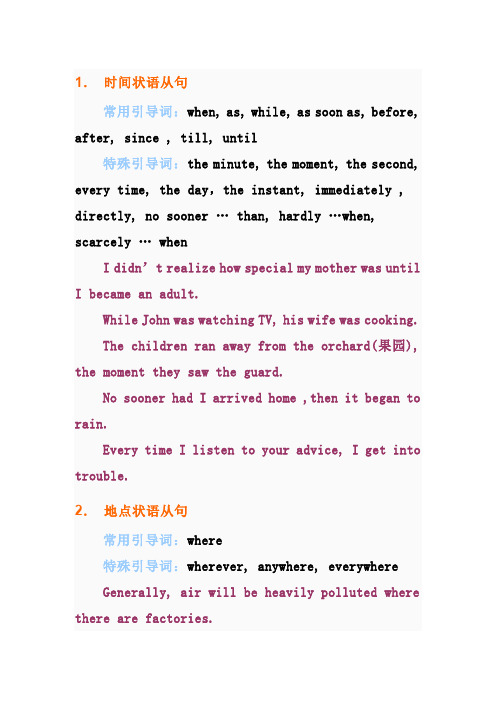
1.时间状语从句常用引导词:when, as, while, as soon as, before, after, since , till, until特殊引导词:the minute, the moment, the second, every time, the day,the instant, immediately , directly, no sooner … than, hardly …when, scarcely … whenI didn’t realize how special my mother was until I became an adult.While John was watching TV, his wife was cooking.The children ran away from the orchard(果园), the moment they saw the guard.No sooner had I arrived home ,then it began to rain.Every time I listen to your advice, I get into trouble.2.地点状语从句常用引导词:where特殊引导词:wherever, anywhere, everywhereGenerally, air will be heavily polluted where there are factories.Wherever you go, you should work hard.地点状语从句§4地点状语从句 (adverbial clause of place) 地点状语从句一般由连接副词where, wherever等引导,已经形成了固定的句型,例如:句型1:Where+地点从句,(there)+主句。
【注意】此句型通常译成“哪里……哪里就……”;主句在从句后面时,there可用可不用;如果主句在从句的前面时,一般都不用there。
高中英语 9类状语从句的用法归纳及备考说明
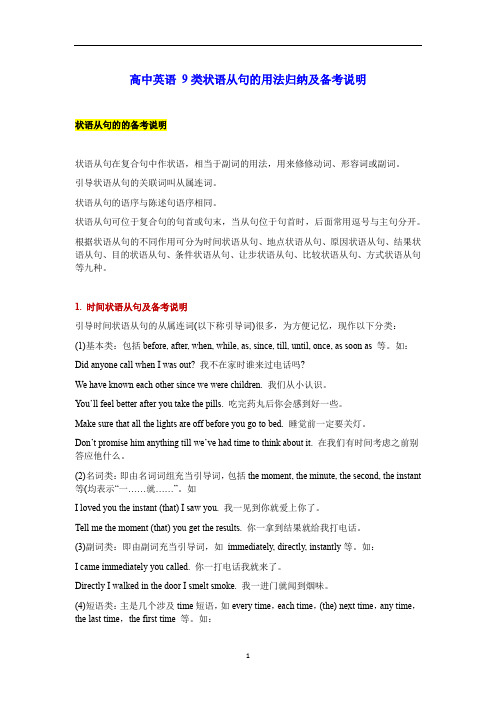
高中英语9类状语从句的用法归纳及备考说明状语从句的的备考说明状语从句在复合句中作状语,相当于副词的用法,用来修修动词、形容词或副词。
引导状语从句的关联词叫从属连词。
状语从句的语序与陈述句语序相同。
状语从句可位于复合句的句首或句末,当从句位于句首时,后面常用逗号与主句分开。
根据状语从句的不同作用可分为时间状语从句、地点状语从句、原因状语从句、结果状语从句、目的状语从句、条件状语从句、让步状语从句、比较状语从句、方式状语从句等九种。
1. 时间状语从句及备考说明引导时间状语从句的从属连词(以下称引导词)很多,为方便记忆,现作以下分类:(1)基本类:包括before, after, when, while, as, since, till, until, once, as soon as 等。
如:Did anyone call when I was out? 我不在家时谁来过电话吗?We have known each other since we were children. 我们从小认识。
You’ll feel better after you take the pills. 吃完药丸后你会感到好一些。
Make sure that all the lights are off before you go to bed. 睡觉前一定要关灯。
Don’t promise him anything till we’ve had time to think about it. 在我们有时间考虑之前别答应他什么。
(2)名词类:即由名词词组充当引导词,包括the moment, the minute, the second, the instant 等(均表示“一……就……”。
如I loved you the instant (that) I saw you. 我一见到你就爱上你了。
Tell me the moment (that) you get the results. 你一拿到结果就给我打电话。
9大状语从句
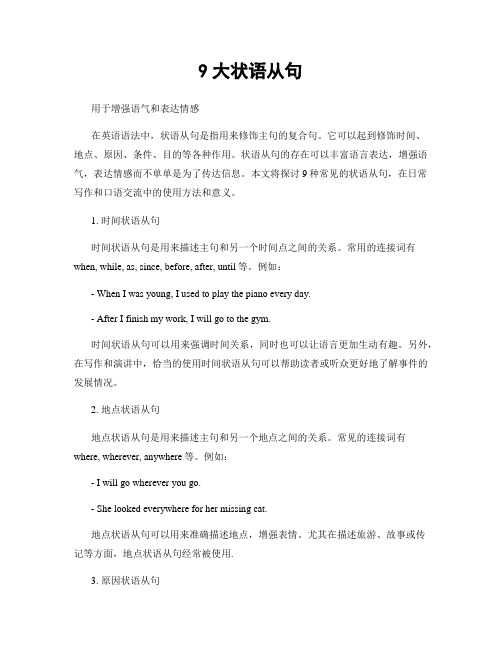
9大状语从句用于增强语气和表达情感在英语语法中,状语从句是指用来修饰主句的复合句。
它可以起到修饰时间、地点、原因、条件、目的等各种作用。
状语从句的存在可以丰富语言表达,增强语气,表达情感而不单单是为了传达信息。
本文将探讨9种常见的状语从句,在日常写作和口语交流中的使用方法和意义。
1. 时间状语从句时间状语从句是用来描述主句和另一个时间点之间的关系。
常用的连接词有when, while, as, since, before, after, until等。
例如:- When I was young, I used to play the piano every day.- After I finish my work, I will go to the gym.时间状语从句可以用来强调时间关系,同时也可以让语言更加生动有趣。
另外,在写作和演讲中,恰当的使用时间状语从句可以帮助读者或听众更好地了解事件的发展情况。
2. 地点状语从句地点状语从句是用来描述主句和另一个地点之间的关系。
常见的连接词有where, wherever, anywhere等。
例如:- I will go wherever you go.- She looked everywhere for her missing cat.地点状语从句可以用来准确描述地点,增强表情。
尤其在描述旅游、故事或传记等方面,地点状语从句经常被使用.3. 原因状语从句原因状语从句是用来描述主句和某个原因之间的关系。
常见的连接词有because, since, as, for等。
例如:- Because it was raining, I stayed at home last night.- I don't like to eat fish, for I am allergic to it.原因状语从句可以强调某个事件的原因,增强语气。
通过使用原因状语从句,写作者或者说话人可以清晰地表达某个事情的原因,使文章更加步入事实,增强可信程度。
完整版)状语从句(9种全)

完整版)状语从句(9种全)状语从句在复合句中起到修饰主句的作用,分为时间、地点、原因、目的、结果、条件、方式、比较、让步等种类。
1.时间状语从句时间状语从句的连接词包括when。
as。
while。
after。
before。
since。
ever since。
as soon as。
once。
till。
until。
whenever。
no sooner…than。
hardly/scarcely。
when。
the moment/minute/instant/second。
every time。
each time。
any time。
the first time。
next time。
last time。
all the time。
by the time。
directly。
immediately。
instantly等。
例如,“一···就···”的句型可以用as soon as或once引导,其中as soon as侧重时间或动作先后衔接紧,而once侧重条件,表示“一旦。
”;on doing sth/on one's + n.作时间状语,例如On arriving at the n。
the thief was arrested.意为“一到达车站,这个小偷就被逮捕了。
”2.地点状语从句地点状语从句的连接词包括where。
wherever。
anywhere。
everywhere等。
例如,I'll go wherever you go.意为“你去哪儿,我就跟你去哪儿。
”3.原因状语从句原因状语从句的连接词包括because。
since。
as。
now that。
seeing that。
considering that等。
例如,Since it's raining。
we'll stay indoors.意为“因为下雨,我们将待在室内。
初中英语状语从句详细讲解与练习(精华版)

对比训练 1
1. __A__ he heard this, he got very angry.
2. I met Lucy__B__ I was walking along the river.
3. __C__ a child, he lived in the countryside. A. when B. while C. as
4. 表示“随着…..”.常指一个行为是另一个行为的结果。 As she grew older, she became more beautiful.
while:持续性动词 /进行时
1.一般或现在情况
e.g. I like listening to music while I am doing my homework 2.将来. 情况-V一般现在时或现在进行时 e.g.— I’m going to the post office.
won in the end.
A. After B. before C. when D. then
since引导的时间状语从句
1.常译为“自从……”, 2.主句常用现在完成时,从句常用一般过去时。
1.我们自从分手以后一直没见过面。 We haven’t seen each other since we parted. 常用句型:It has been (is) + 时间段 + since从句
-- While you are there, can you get some stamps for me?
3.过去情况
e.g. I hurt my should while I was doing gym.
When: 1.当…的时候 When I was young, I went to town myself. When he receives the letter, he’ll tell us.
状语从句的9种形式

状语从句的9种形式状语从句是一种在句子中作状语的从句,它有9种形式:时间、地点、原因、条件、方式、让步、结果、比较和目的。
一、时间状语从句时间状语从句用来表示句子发生的时间,一般要用when或while引导:When I was a child, I used to play with my friends every day. 我小时候每天都和朋友玩耍。
While I was studying in the library, someone stole my bag. 我在图书馆学习时,有人偷了我的书包。
注意:在某些情况下,when和while可以互换使用,但不能混用。
二、地点状语从句地点状语从句表示句子发生的地点,一般要用where 引导:Where there is a will, there is a way. 有志者事竟成。
He lives where he works. 他住在他工作的地方。
三、原因状语从句原因状语从句表示句子发生的原因,一般要用why或because引导:Why she is late? 她为什么迟到?Because it was raining heavily, I couldn't get to school on time. 因为下着大雨,我上不了学。
四、条件状语从句条件状语从句表示句子发生的条件,一般要用if或unless引导:If you study hard, you'll pass the exam. 如果你努力学习,你就能通过考试。
Unless you work harder, you won't get better grades. 除非你更努力工作,否则你的分数不会提高。
五、方式状语从句方式状语从句表示句子的发生方式,一般要用as或how引导:As I said before, I'll help you with your project. 就像我之前说的,我会帮助你完成这个项目。
课件(目的状语从句)

3)as引导原因状语从句时表示附带说明 的“双方已知的原因”,含有对比说 明的意味,语气比since弱,较为正式, 位置较为灵活(常放于主句之前)
eg:As it is raining, you’d better take a taxi.
4)for表示原因,但并不说明主句行 为发生的直接原因,只提供一些辅 助性的补充说明,for只能放于主 句之后并且必须用逗号将其与主句 隔开。
目的状语从句:从句部分是用来补充 说明主句中谓语动词发生的目的的状 语从句。
常见的引导目的状语从句的引导词:so that(以便,为了),in order that(以
便,为了),且从句中有情态动词
can,could,will,would,may,might等。
I hurried B I would not late
for class. A since B so that C as if D unless
析:so that 引导的目的状语从句。
当主句和从句的主语一致时,in order to do sth.结构。
They both worked day and night in order that they could pay off their debt. They both worked day and night in order to pay off their debt.
eg:He seldom goes out now, for he is very old
because, as, since, for:
语 位置 意义
气
because 最 前或 “原因”;表客观因果 强 后 关系;回答的
强
事实当作理由
状语从句
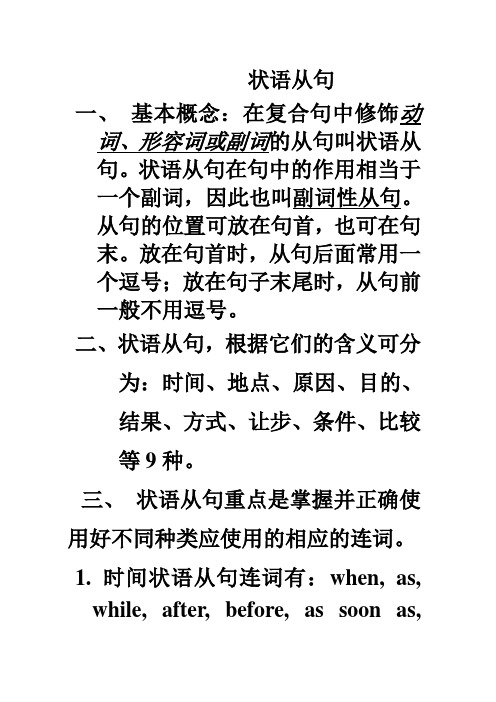
状语从句一、基本概念:在复合句中修饰动词、形容词或副词的从句叫状语从句。
状语从句在句中的作用相当于一个副词,因此也叫副词性从句。
从句的位置可放在句首,也可在句末。
放在句首时,从句后面常用一个逗号;放在句子末尾时,从句前一般不用逗号。
二、状语从句,根据它们的含义可分为:时间、地点、原因、目的、结果、方式、让步、条件、比较等9种。
三、状语从句重点是掌握并正确使用好不同种类应使用的相应的连词。
1. 时间状语从句连词有:when, as,while, after, before, as soon as,since, till (until) , once, whenever, no sooner…than, hardly…when, scarcely …when, the moment, every time, immediately, the instant, directly, etc.e.g. I was going over my lessons when my mother came in .Don’t speak while you are eating. We discussed his suggestion as we went along.2.注:由as soon as ,no sooner…than,hardly/scarcely…when等引导的状语从句,这些词都可译为“一…就”之意e.g. Please come to my office as soon as the class is over.I had hardly/scarcely got to the office when the manager left.He had no sooner entered the room than the phone rang.No sooner had he entered the room than the phone rang.1.搭配 2 时态 3 倒装3. When的用法:1)表时间,“当…时候”可引导“点时间”,也可以引导“段时间”The fire was put out when they came.I hope you’ll think of my wordswhen you drive on the busy roads. 【例】(2005上海) He transplanted the little tree to the garden______ it was the best time forit.A. whereB. whenC. thatD. until【答案】B【解析】when引起的时间状语从句,用来表示植树这一动作发生的时间。
九种状语从句
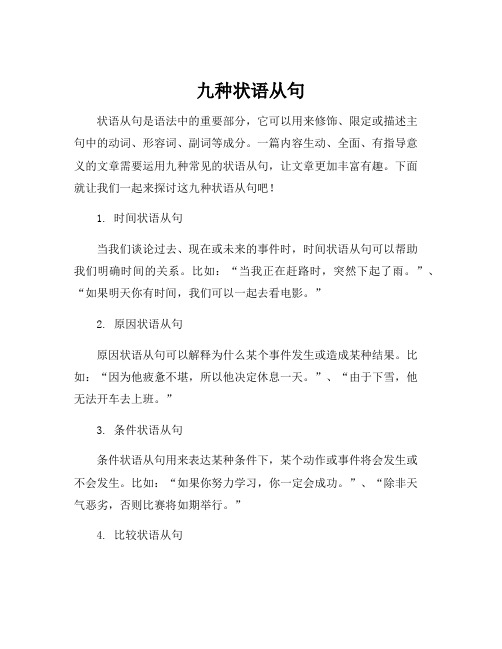
九种状语从句状语从句是语法中的重要部分,它可以用来修饰、限定或描述主句中的动词、形容词、副词等成分。
一篇内容生动、全面、有指导意义的文章需要运用九种常见的状语从句,让文章更加丰富有趣。
下面就让我们一起来探讨这九种状语从句吧!1. 时间状语从句当我们谈论过去、现在或未来的事件时,时间状语从句可以帮助我们明确时间的关系。
比如:“当我正在赶路时,突然下起了雨。
”、“如果明天你有时间,我们可以一起去看电影。
”2. 原因状语从句原因状语从句可以解释为什么某个事件发生或造成某种结果。
比如:“因为他疲惫不堪,所以他决定休息一天。
”、“由于下雪,他无法开车去上班。
”3. 条件状语从句条件状语从句用来表达某种条件下,某个动作或事件将会发生或不会发生。
比如:“如果你努力学习,你一定会成功。
”、“除非天气恶劣,否则比赛将如期举行。
”4. 比较状语从句比较状语从句用来比较两个或多个事物之间的差异或相似之处。
比如:“他弟弟比他更高。
”、“这个城市比我之前去过的任何一个城市都要美丽。
”5. 目的状语从句目的状语从句用来说明一个动作的目的或意图。
比如:“我带着伞出门,以便在下雨时不被淋湿。
”、“我希望今天能早点完成工作,以便有时间陪家人。
”6. 结果状语从句结果状语从句用来描述某个动作或事件的结果。
比如:“他在考试中取得了好成绩,因此他非常开心。
”、“他没来参加会议,结果被罚款了。
”7. 让步状语从句让步状语从句用来表示与主句相反或相对独立的情况。
比如:“尽管她很累,但她还是坚持完成了任务。
”、“虽然下雨了,但我们还是坚持去爬山。
”8. 方式状语从句方式状语从句用来描述某个动作或事件的方式或方法。
比如:“他走路时像风一样迅速。
”、“我用力地挥舞着手臂,好让朋友看到我。
”9. 地点状语从句地点状语从句用来说明一个动作或事件发生的地点。
比如:“我们约定在公园里见面。
”、“我在你旁边坐着等你。
”通过运用这九种状语从句,我们可以大大丰富文章的表达,使文章更加生动、有趣。
状语从句(9种全)
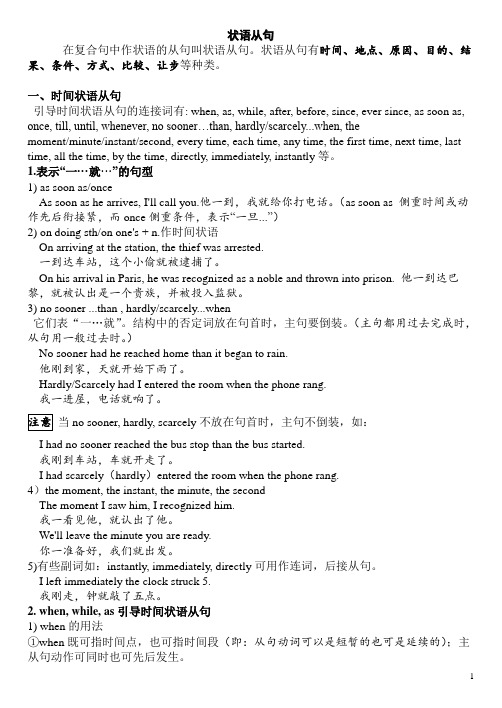
状语从句在复合句中作状语的从句叫状语从句。
状语从句有时间、地点、原因、目的、结果、条件、方式、比较、让步等种类。
一、时间状语从句引导时间状语从句的连接词有: when, as, while, after, before, since, ever since, as soon as, once, till, until, whenever, no sooner…than, hardly/scarcely...when, themoment/minute/instant/second, every time, each time, any time, the first time, next time, last time, all the time, by the time, directly, immediately, instantly等。
1.表示“一···就···”的句型1) as soon as/onceAs soon as he arrives, I'll call you.他一到,我就给你打电话。
(as soon as 侧重时间或动作先后衔接紧,而once侧重条件,表示“一旦...”)2) on doing sth/on one's + n.作时间状语On arriving at the station, the thief was arrested.一到达车站,这个小偷就被逮捕了。
On his arrival in Paris, he was recognized as a noble and thrown into prison. 他一到达巴黎,就被认出是一个贵族,并被投入监狱。
3) no sooner ...than , hardly/scarcely...when它们表“一…就”。
结构中的否定词放在句首时,主句要倒装。
9种状语从句

9种状语从句标题:了解九种常见的状语从句状语从句是语法中的一种重要结构,用于描述或修饰主句中的动作、时间、原因、条件等。
下面将介绍九种常见的状语从句。
1.时间状语从句:当我们需要描述一个动作发生的时间时,可以使用时间状语从句。
例如,“我会在你回来之前完成作业。
”2.原因状语从句:原因状语从句用于解释主句中的原因或理由。
例如,“由于下雨,他没有去上学。
”3.条件状语从句:条件状语从句描述了主句中的动作发生的前提条件。
例如,“如果你明天来,我们可以一起去看电影。
”4.方式状语从句:当我们需要描述一个动作或事件的方式时,可以使用方式状语从句。
例如,“他唱歌的方式让人感动。
”5.地点状语从句:地点状语从句用于描述主句中的动作发生的地点。
例如,“我在哪儿等你,你就来哪儿。
”6.目的状语从句:目的状语从句解释了主句中的动作的目的或意图。
例如,“我去超市买东西,是为了准备晚餐。
”7.结果状语从句:结果状语从句用于描述主句中的动作的结果或后果。
例如,“他学习努力,所以考试取得了好成绩。
”8.让步状语从句:让步状语从句用于表达与主句中的动作相反的情况。
例如,“尽管下雨了,但他还是去跑步了。
”9.比较状语从句:比较状语从句用于进行比较。
例如,“她比我更聪明。
”以上是九种常见的状语从句,每一种都有不同的用法和功能。
在写作中,熟练掌握这些状语从句的用法,可以丰富句子的表达方式,使文章更加清晰和有逻辑。
总结一下,文章介绍了九种常见的状语从句,包括时间、原因、条件、方式、地点、目的、结果、让步和比较状语从句。
正确使用这些状语从句可以使文章更加流畅和表达更加准确。
- 1、下载文档前请自行甄别文档内容的完整性,平台不提供额外的编辑、内容补充、找答案等附加服务。
- 2、"仅部分预览"的文档,不可在线预览部分如存在完整性等问题,可反馈申请退款(可完整预览的文档不适用该条件!)。
- 3、如文档侵犯您的权益,请联系客服反馈,我们会尽快为您处理(人工客服工作时间:9:00-18:30)。
1.时间状语从句常用引导词:when, as, while, as soon as, before, after, since , till, until 特殊引导词:the minute, the moment, the second, every time, the day,theinstant, immediately , directly, no sooner … than, hardly …when, scarcely …whenI didn't realize how special my mother was until I became an adult. While John was watching TV, his wife was cooking.The childre n ran away from the orchard果园),the mome nt they saw the guard.No sooner had I arrived home ,then it began to rain.Every time I listen to your advice, I get into trouble.2.地点状语从句常用引导词:where特殊引导词:wherever, anywhere, everywhereGenerally, air will be heavily polluted where there are factories. Wherever you go, you should work hard.地点状语从句§4地点状语从句(adverbial clause of place) 地点状语从句一般由连接副词where, wherever 等引导,已经形成了固定的句型,例如:句型1: Where+地点从句,(there)+主句。
【注意】此句型通常译成“哪里……哪里就……”;主句在从句后面时,there 可用可不用;如果主句在从句的前面时,一般都不用there。
例如:1 / 15Where there is no rain, farmi ng is difficult or impossible 在没有雨水的地方,耕作是困难的,或根本不可能的。
You should have put the book where you found it. 你本来应该把书放回原来的地方。
Where the Communist Party of China goes, there the people are liberated.哪里有了中国共产党,哪里人民得解放。
句型2:Any where/ wherever +地点从句,+主句。
【注意】anywhere 本身是个副词,但是,常可以引导从句,相当于连词,意思相似于wherever, anywhere 引导的从句可位于主句之前,也可以位于主句之后。
而wherever 本身就是个连词,表示“在何处,无论何处” 。
例如:Wherever the sea is , you will find seamen有海就有海员。
3回答者:快乐如3.原因状语从句常用引导词:because, since, as, for特殊引导词:seeing that, now that, in that, considering that, given that. My friends dislike me because I'm handsome and successful.4.目的状语从句常用引导词:so that, in order that特殊引导词:lest, in case, for fear that, in the hope that, for the purpose that,to the end thatThe boss asked the secretary to hurry up with the letters so that he could sign them.The teacher raised his voice on purpose that the students in the back could hearmore clearly.2 / 155.结果状语从句常用引导词:so …that, such …that,特殊引导词:such that, to the degree that, to the extent that, to such a degreethat,He got up so early that he caught the first bus. It's such a good chance that we must not miss it.To such a degree was he excited that he couldn't sleep last night.6.条件状语从句常用引导词:if, unless,特殊引导词:as/so long as, only if, providing/provided that, supposing that, incase that, on condition thatWe'll start our project if the president agrees.You will certainly succeed so long as you keep on trying.Provided that there is no opposition, we shall hold the meeting here. 7.让步状语从句常用引导词:though, although, even if, even though特殊引导词:as(用在让步状语从句中必须要倒装),while (一般用在句首),no matter …,in spite of the fact that, while, whatever, whoever, wherever, whenever, however, whicheverMuch as I respect him, I can't agree to his proposal.尽管我很尊敬他,我却不同意他的建议。
The old man always enjoys swimming even though the weather is rough.3 / 15No matter how hard he tried, she could not change her mind.He won't listen whatever you may say.8.比较状语从句常用引导词:as同级比较),than(不同程度的比较)特殊引导词:the more … the more … ;just as …,so…;A is to B what /as X isto Y; no … more than; not A so much as BShe is as bad-tempered as her mother.The house is three times as big as ours.The more you exercise, the healthier you will be.Food is to men what oil is to machine. 食物之于人,犹如油之于机器。
9.方式状语从句常用引导词:as, as if, how特殊引导词:the wayWhen in , do as the Roman do.She behaved as if she were the boss.Sometimes we teach our children the way our parents have taught us.三、条件状语从句要点:表示状语从句由连词if, unless (=if not)引导。
1.If it doesn't rain tomorrow, we will go hiking.如果明天不下雨, 我们就去远足.2. You will get good grades if you study hard.4 / 15如果你努力学习,就会取得好成绩.3.I will go to the party unless he goes there too. 我会去参加聚会的, 除非他也去.(如果他不去,我就去.)4.You will be late unless you leave immediately.如果你不马上走,你将会迟到的.(=If you don't leave immediately, you will be late.)难点提示:用条件状语从句时要注意时态的正确使用,当主句是将来时的时候,从句要用一般现在时.lHe will not leave if it isn't fine tomorrow.一般将来时,一般现在时lThey are going to have a picnic if it doesn't rain next week. 一般将来时, 一般现在时.难点--- because , since , as , fc辨析1) because语势最强,用来说明人所不知的原因,回答why提出的问题。
当原因是显而易见的或已为人们所知,就用as或since。
I didn't gc, because I was afraid.Since /As the weather is sc bad, we have tc delay cur jcurney.2) 由because引导的从句如果放在句末,且前面有逗号,则可以用fcr 来代替。
但如果不是说明直接原因,而是多种情况加以推断,就只能用fcr。
He is absent tcday, becaus e / fcr he is ill.He must be ill, fcr he is absent tcday.3)as 和for 的区别:5 / 15通常情况下,as引导的从句在主句前,for引导的从句在主句后。
例:As the weather is cold, I stay at home(. 同义句)I stay at home, for the weather is cold.五、目的状语从句要点:目的状语从句由连词that, so that, so…that , in order that引导1. so that 以至, 以便I'll run slowly so that you can catch up with me. (目的)我将慢慢跑以至你能赶上我。
